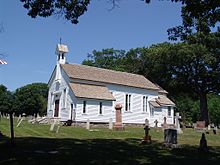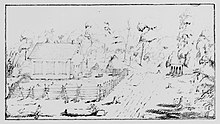
Penetanguishene is a town in Simcoe County, Ontario, Canada. It is located on the southeasterly tip of Georgian Bay. Incorporated on February 22, 1882, this bilingual community has a population of 8,962 in the Canada 2016 Census.

The Cathedral Church of St. James is an Anglican cathedral in Downtown Toronto, Ontario, Canada. It is the location of the oldest congregation in the city, with the parish being established in 1797. The church, with construction beginning in 1850 and opening for services on June 19, 1853, was one of the largest buildings in the city at that time. It was designed by Frederick William Cumberland and is a prime example of Gothic Revival architecture.

Little Trinity Anglican Church is a parish church of the Anglican Church of Canada. It is located at 425 King Street East in the Corktown neighbourhood, just east of downtown Toronto, Ontario, Canada. An Ontario Heritage Trust plaque at the site notes that the 1844 church is the oldest surviving church in the city.
Captain John Moberly was born in St. Petersburg, Russia, the son of an English merchant, Edward Moberly, a freeman of the Russia Company. He entered the Navy in 1801 when he was only 12 and by 1815 had become a post Captain, serving on a number of ships.

The Reformed Church of Beacon, originally the Reformed Dutch Church of Fishkill Landing, is a historic and architecturally-significant church in Beacon, New York. The congregation, who no longer occupies the building, claims it is the oldest church in Beacon. It is located on NY 9D about 0.5 miles (1 km) south of Beacon's municipal complex and downtown area and overlooks the Hudson River from a bluff.
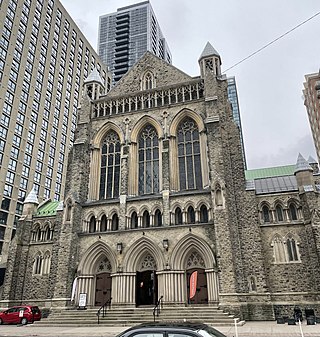
St. Paul's, Bloor Street, is an Anglican church located at 227 Bloor Street East in Toronto, Ontario. The present church building, completed in 1913, was designed by E. J. Lennox in the Gothic Revival style. At 10,000 square metres (110,000 sq ft), it is the largest church in the Diocese of Toronto. The building is designated under Part IV of the Ontario Heritage Act as being of cultural heritage value or interest. It is the regimental church of The Queen's Own Rifles of Canada.

St. Anne's Chapel is a Gothic Revival Anglican chapel of ease in Fredericton, New Brunswick. Constructed between 1846 and 1847, it was designed by British-born architect Frank Wills. St. Anne's Chapel is a National Historic Site of Canada.

St Mary's Church is an Anglican church in the Kemptown area of Brighton, in the English city of Brighton and Hove. The present building dates from the late 1870s and replaced a church of the same name which suddenly collapsed while being renovated. The Gothic-style red-brick building, whose style resembles Early English revival and French Gothic revival, is now a Grade II* listed building, and remains in use despite threats of closure.

St Paul's Church is in Scotforth, a suburb of Lancaster, Lancashire, England. It is recorded in the National Heritage List for England as a designated Grade II listed building. It is an active Anglican parish church in the deanery of Lancaster, the archdeaconry of Lancaster and Morecambe, and the diocese of Blackburn. The architectural historian Nikolaus Pevsner described it as a "strange building" and "an anachronism, almost beyond belief".

St. John's Episcopal Church is a historic church on the south side of Maine State Route 27 at Blinn Hill Road in Dresden Mills, Maine. Built in 1832, it is a distinctive architectural blend of Federal, Greek Revival and Gothic Revival styling. It was listed on the National Register of Historic Places in 1991.

St. Paul's Episcopal Church is a parish church in the Diocese of Iowa. The church is located in Durant, Iowa, United States. The church building and parish hall have been listed on the National Register of Historic Places since 1985.

First German Reformed Church was a historic church built in 1891 at 413 Wisconsin Avenue in Waukesha, Wisconsin, United States. It was added to the National Register of Historic Places in 1991. The 1891 building burned to the ground in 2005.

St James Church is a heritage-listed Anglican church at 145 Mort Street, Toowoomba, Queensland, Australia. It was designed by Richard George Suter and built from 1869 to 1953. It is also known as St James Church of England. It was added to the Queensland Heritage Register on 28 July 2000.

St Patrick's Church is a heritage-listed Roman Catholic church at 58 Morgan Street, Fortitude Valley, City of Brisbane, Queensland, Australia. It was designed by Andrea Giovanni Stombuco and built from 1880 to 1882 by John Arthur Manis O'Keefe. It was added to the Queensland Heritage Register on 21 October 1992.

St Paul's Presbyterian Church, Hamilton is a congregation of the Presbyterian Church in Canada located at the city centre of Hamilton, Ontario. The church building, designed by renowned architect William Thomas, is federally designated as a National Historic Site in Canada and provincially designated by the province of Ontario as a heritage site under the Ontario Heritage Act.

St. John's Episcopal Church is a historic church at 768 Fairfield Avenue in Bridgeport, Connecticut. Built in 1873 for a congregation founded in the mid-18th century, it is a well-preserved design of James Renwick, Jr. and a good example of late 19th-century Gothic Revival archiecture. It was listed on the National Register in 1984.
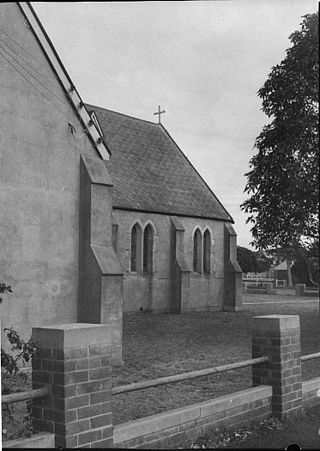
The St John's Anglican Church, formally the Church of St John the Evangelist, also called St John's Cooks Hill, is an Anglican church in Newcastle, New South Wales, Australia. It is the oldest remaining church building in Newcastle, completed in 1860. The building, the design of which is attributed to colonial architect Edmund Blacket, in the Old Colonial Grecian Revival style, is located close to the city centre at 1D Parry Street, Cooks Hill. It was added to the New South Wales State Heritage Register on 2 April 1999.

St John the Baptist Anglican Church is a heritage-listed church at Crawford Street, Richmond, Shire of Richmond, Queensland, Australia. It was built in 1909 by Mr Moore of Hughenden. It was added to the Queensland Heritage Register on 25 February 2000.
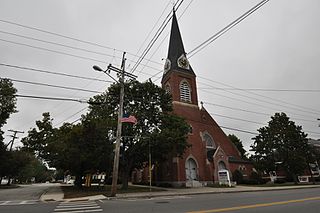
The First Congregational Church is a historic church at 400 Main Street in Farmington, New Hampshire. Built in 1875 for a congregation founded in 1819, it is the oldest church building in the town, and a distinctive example of Gothic Revival architecture designed by New Hampshire native Frederick N. Footman. The church was added to the National Register of Historic Places in 2018, and the New Hampshire State Register of Historic Places in 2017. The congregation is affiliated with the United Church of Christ.
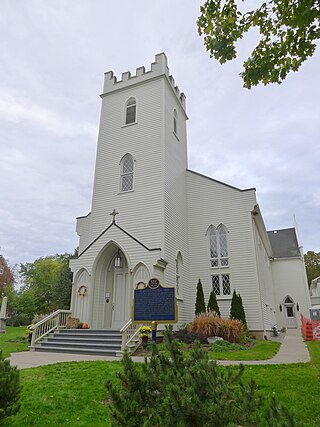
St. Mark's Anglican Church is a historic Anglican church in Port Hope, Ontario, Canada. The Carpenter Gothic church building dates from the 1820s and was the original home of St. John the Evangelist Anglican Church, now located in a larger stone building on Pine Street. The congregation dedicated to St. Mark was established in 1873.
